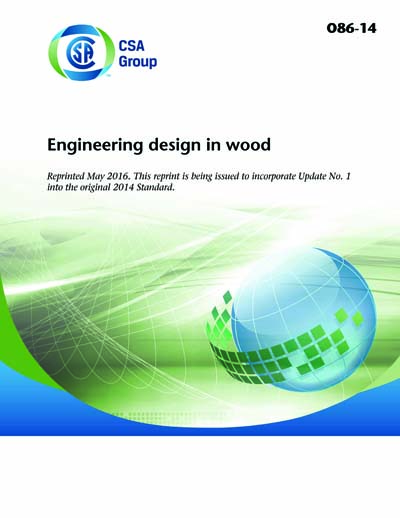Most recent
CSA O86-14 (R2019)
Engineering design in wood
Preface This is the tenth edition of CSA O86, Engineering design in wood. It is presented in limit states design (LSD) format, and supersedes the previous editions published in 2009, 2001, 1994, 1989, 1984, 1980, 1976, 1970, and 1959, including their Supplements. Editions of CSA O86 published in 1959, 1970, 1976, 1980, and 1984 were all developed using working stress design (WSD) theory. The last WSD version, CSA CAN3-O86-M84, Engineering Design in Wood (Working Stress Design), existed concurrently with the first (1984) and second (1989) LSD versions, Engineering Design in Wood (Limit States Design). The WSD version was withdrawn on publication of the 1994 LSD edition. Three LSD editions were published in 1984, 1989, and 1994 with the CSA designation O86.1. Supplements to each of these editions were published in 1987, 1993, and 1998, respectively. Although the 2001 edition was also based on the LSD method, the O86 designation was reinstated. Changes in this edition include the following: - Clause 8 has been added for CLT in compression and out-of-plane bending applications; - Clause 11.9 has been added for the design of CLT shearwalls and diaphragms for platform-type construction; - Clause 12 has been modified to cover connections in CLT; - Clause 12 has been modified to cover embedment resistance of nails, screws, lags, bolts, and dowels in mild and cold-formed steel as well as head pull-through resistance of screws in steel; - Annex B, on fire resistance of large cross-section wood elements, has been modified to cover CLT; - reduction in the concentrated loaded area on roof deck has been incorporated; - requirements for anticipated building movement due to shrinkage and swelling have been added; - requirements for lateral brace forces for wood truss compression webs have been included; - revisions have been made to finger-jointed lumber grades; - revisions have been made to the shear and bending moment resistance of glued-laminated timber; - lateral-load-resisting provisions have been modified; - design of diaphragms and shearwalls have been revised; - lag screw requirements have been adjusted; - reaction requirements for proprietary wood products have been added; and - strength resistance of truss plates and ultimate load of joist hangers have changed. Scope 1.1 This Standard provides criteria for the structural design and appraisal of structures or structural elements made from wood or wood products, including graded lumber, glued-laminated timber, unsanded plywood, oriented strandboard (OSB), composite building components, shearwalls and diaphragms, timber piling, pole-type construction, prefabricated wood I-joists, structural composite lumber products, preserved wood foundations, and their structural connections. This Standard employs the limit states design method. 1.2 In CSA Standards, "shall" is used to express a requirement, i.e., a provision that the user is obliged to satisfy in order to comply with the standard; "should" is used to express a recommendation or that which is advised but not required; "may" is used to express an option or that which is permissible within the limits of the standard. Notes accompanying clauses do not include requirements or alternative requirements; the purpose of a note accompanying a clause is to separate from the text explanatory or informative material. Notes to tables and figures are considered part of the table or figure and may be written as requirements. Annexes are designated normative (mandatory) or informative (non-mandatory) to define their application.
CSA America, Inc. [csa]

